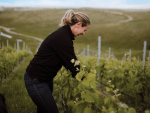Wet season dampens spirits
Organic winemakers in the Wairarapa had their spirits dampened by rain this season, but organics remains the way of the future for many producers.
The word comes from the Latin word valere, which means 'be worth'.
This definition focuses on products that represent good value for how much they cost rather than providing accessibility and affordability at the (possible) expense of desirability.
When it comes to wines that deliver on the value for money or QPR (quality price ratio), the word 'value' is most often used for lower priced, higher volume products. But there are wines with a high QPR produced in New Zealand, which are higher up the scale. This story focuses on three of them.
Tim Kerruish, co-owner, founder and vigneron of Folding Hill Wines in Bendigo, produces a second tier Pinot Noir, which stands out not only in taste (when tasted blind) but also when its price tag is taken into consideration. This wine consistently stands out due to its concentration of flavour (ripe Bendigo fruit) and its full body (that ripeness again and, in part, because it is not fined or filtered).
Its retail price remains modest, in contrast to many winery's first tier Pinot Noirs; it costs $29 to $30 a bottle.
Kerruish says that the wine, Folding Hill Ballasalla Pinot Noir, is a blend of barrels that don't make it into the Folding Hill label, some of which have been cropped at a higher level. The wine making is the same as for his top label, but Ballasalla does not go into any new oak barrels whereas Folding Hill Pinot Noir does; 25-30% new Francois Frere barriques. The packaging costs are also lower for the second tier Pinot Noir, Ballasalla.
"I like the concept of QPR; the quality / price ratio, and we price our wines to try and over deliver on quality for the price, at all of our price points. I don't see that principle changing in the future," says Kerruish, who says that he follows standard price points of $20, $30, $40 and, occasionally, over $50.
He rarely spends more than $50 on a bottle of wine because he sees a law of diminishing returns.
Martinborough winemaker Helen Masters of Ata Rangi agrees that there is a law of diminishing returns, but says there can be a trap in trying to peg quality to value for money within price bands where wine is concerned.
"I've been surprised (pleasantly) by $20 wines and unpleasantly by $100 ones."
Masters also notes that any percentage increase in price is higher than the increase in quality.
"I'm not sure there's a perfect sweet spot for a price to quality ratio. It depends on different production costs for different varieties. There are certain fundamentals about the cost structure of making great quality wine, and that inevitably has to flow through to price," she says.
Containing the costs of oak maturation and packaging are two ways to provide value for money. Another one is to grow the grapes rather than purchase them, says Phil Hanford, one of the founders and owners of Grasshopper Rock Wines in Alexandra.
All of the grapes in Grasshopper Rock Pinot Noir are estate-grown. This has been an intentional strategy from the start, which, Hanford says, was designed to promote quality and cost control.
Grasshopper Rock was first launched in 2008, which makes it a young brand and as such, Hanford says, it would be unreasonable to expect consumers to pay what they might for a premium wine label that had built a reputation over 20 years or longer.
"Starting in the middle of the global financial crisis was a tough time for us with a new wine label, so we realised at the start that we had to over-deliver on quality for the price. This has happened and not simply because the wine is well priced but more importantly because the quality is consistently high."
This theory is supported not only by strong awards on the wine show circuit for this wine, but also by sales. Grasshopper Rock Pinot Noir, sells out each year and now operates on allocation for the trade.
The notion of QPR means different things to different people too, says Masters of Ata Rangi.
"I might not even like a wine that has been scored, say, high points from Parker, but it might deliver an experience that I do enjoy, so the value was good."
This would not translate as a good QPR for many wine drinkers, however, such as those who Masters and the Ata Rangi team are targeting with their second tier Pinot Noir; Crimson.
"We approach winemaking for Crimson in the same way as our signature Pinot Noir, looking each year for a final blend that best reflects the facets and features of the particular season," says Masters.
Value is delivered by slightly higher crop levels and younger vines.
The vines that grow the Pinot Noir grapes in Crimson tend to be up to 20 years of age, compared to the 35 year old vines from which Ata Rangi Pinot Noir is made. Both are subject to the same harsh Wairarapa climatic influences, however, which means spring winds, low yields and smaller bunches and berries as a result. It is a tough way to make a living, but one that makes for more complex wines with high flavour intensity (due to small berry sizes). This is equally true for Crimson and Ata Rangi Pinot Noir, except that the vines for the latter yield particularly small amounts: "It's certainly not cheap to produce," says Masters.
"Crimson is about accessibility. We'd like people to have the experience of good Pinot Noir, explore the variety and Martinborough's unique impact on it. It's also been an alliance in support of Project Crimson for over a decade now. The more people who can hear of the work in reforestation of rata and pohutukawa, the better. Could we command more for it? Undoubtedly, but a price jump for Crimson isn't immediately on our radar. Making it consistently better each year is."

OPINION: Harvest begins, and almost immediately we start to get media enquiries about how the vintage is going and whether it…

OPINION: Rachael Cook is the smiling grape grower on this month’s cover, tending vines on the miniscule, beautiful and dream-driven vineyard…
New Zealand wine enthusiasts have a deepening understanding and growing appreciation of sparkling wine, says Mel Skinner, Chair of Méthode Marlborough…
One of the biggest mistakes wine marketers make is in assuming consumers are as passionate and knowledgeable about wine as…
Taking two sustainability awards at two events on a single evening felt like "true recognition" of the work Lawson's Dry…